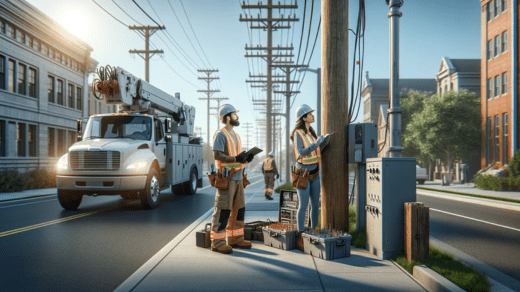In the ever-evolving world of infrastructure and utility management, one aspect that often goes unnoticed but is of paramount importance is utility pole testing. These seemingly unassuming structures play a critical role in our daily lives by supporting overhead power lines, telephone lines, and various other utilities. However, their significance becomes glaringly evident when they fail, leading to power outages, communication disruptions, and even safety hazards.
At [Your Company Name], we understand the pivotal role that utility poles play in maintaining a functional and safe infrastructure. In this comprehensive article, we will delve deep into the world of utility pole testing, its significance, methodologies, and how it contributes to ensuring safety and reliability in your community.
The Crucial Role of Utility Poles
Utility poles, often made from wood, steel, or concrete, are the unsung heroes of our modern world. They stand tall, bearing the weight of numerous cables and wires that crisscross our cities and towns. These poles are the backbone of our communication networks, electricity distribution systems, and even the internet.
- Supporting Power Distribution
Utility poles are primarily responsible for supporting power lines, ensuring that electricity reaches our homes, schools, hospitals, and businesses. Any failure in these poles can lead to widespread power outages, disrupting our daily lives and causing financial losses.
- Enabling Communication
Telephone and internet connectivity rely heavily on utility poles to carry the necessary infrastructure. When these poles are compromised, it can result in communication breakdowns, affecting emergency services, businesses, and personal communications.
- Safety First
Besides their utility, these poles also play a significant role in ensuring public safety. They are often equipped with streetlights and traffic signals, contributing to road safety during nighttime hours. Damaged or unstable poles pose a considerable risk to pedestrians and motorists alike.
Understanding Utility Pole Testing
Utility pole testing is a systematic process aimed at assessing the condition of utility poles to determine their safety and reliability. Regular testing and inspection are essential to identify potential issues before they escalate into emergencies.
Why Utility Pole Testing Matters
The importance of utility pole testing cannot be overstated. Here’s why it matters:
- Safety: Ensuring the structural integrity of utility poles helps prevent accidents, such as poles collapsing onto roadways or power lines falling during storms.
- Reliability: Regular testing helps utilities predict when a pole may need replacement or reinforcement, reducing the likelihood of unexpected service disruptions.
- Cost-Efficiency: Identifying and addressing issues early can save substantial costs compared to emergency repairs and replacements.
Methods of Utility Pole Testing
Utility pole testing employs various methodologies and technologies to assess the condition of these vital structures. Some of the most common methods include:
- Visual Inspection
Visual inspections involve a thorough examination of the pole’s exterior, looking for visible signs of decay, damage, or wear. This is often the first step in assessing a pole’s condition.
- Sound and Tap Testing
This method involves using a hammer or mallet to tap the pole at various points, listening for differences in sound. Hollow or dull sounds can indicate internal decay or damage.
- Ground Line Testing
Ground line testing assesses the portion of the pole that is buried underground, as this area is prone to rot and decay. Specialized equipment can measure the moisture content and integrity of this critical section.
- Load Testing
Load testing involves applying controlled loads to the pole to evaluate its strength and stability. This method helps determine if the pole can support its intended load safely.
- Advanced Technologies
In recent years, advanced technologies such as ultrasound and radar have been employed to assess the internal condition of utility poles with a high degree of accuracy.
The Importance of Routine Testing
Routine utility pole testing is essential to maintain the reliability and safety of utility networks. It allows for the early detection of potential issues, preventing catastrophic failures that could result in extended outages and costly repairs.
Frequency of Testing
The frequency of utility pole testing may vary depending on several factors, including the pole’s material, age, and environmental conditions. However, in general, poles should be tested every 5 to 7 years to ensure their continued reliability.
The Future of Utility Pole Testing
As technology advances, so does the field of utility pole testing. Innovations in materials, sensors, and data analytics are transforming the way we assess and manage these essential structures.
- Smart Poles
The concept of “smart poles” is gaining traction, where utility poles are equipped with sensors and monitoring systems. These devices can continuously collect data on a pole’s condition and transmit it to a central monitoring station for real-time analysis.
- Predictive Analytics
With the help of predictive analytics, utilities can anticipate when a pole is likely to fail and proactively address the issue, reducing downtime and service disruptions.
Utility pole testing is an indispensable aspect of infrastructure management that often goes unnoticed but plays a vital role in ensuring the safety, reliability, and efficiency of our utility networks. Regular testing, using a combination of traditional methods and advanced technologies, is the key to preventing emergencies and maintaining the seamless operation of our power and communication systems.
At [Your Company Name], we are committed to the highest standards of utility pole testing, helping to safeguard your community’s infrastructure. Our experienced team and state-of-the-art equipment ensure that utility poles remain strong and reliable, even in the face of adverse conditions.

